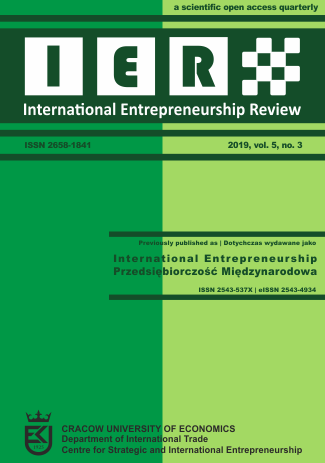An attempt to estimate the competency gap in the IT sector

Abstract
Objective: The aim of this article is to determine whether there is a gap between the demand for competencies of graduates of the computer science major and their supply.
Research Design & Methods: Identification of the key set of competencies required by employers from job applicants and estimation of the competency gap in the IT sector was conducted using the method of exploratory analysis of job offers for positions related to the administration of IT systems.
Findings: The results of the preliminary research shown that proposed method can be used for estimation of competency gap however it requires more experiments.
Contribution & Value Added: Proposition of new method for competency gap calculation based on exploratory analysis of data available in the Internet.
Keywords
competency, competency gap, labour market, IT sector, Latent Dirichlet Analysis
Author Biography
Paweł Lula
He obtained a doctoral degree and a habilitation degree at the Cracow University of Economics. His research interests include data analysis methods and tools, information technology, artificial intelligence, methods of web, graph and text mining.
Renata Oczkowska
She obtained a doctoral degree and a habilitation degree at the Cracow University of Economics. Her research interests include employee competencies, labour market, globalization and internationalization of enterprises.
Sylwia Wiśniewska
She obtained a doctoral degree at the Cracow University of Economics. Her research interests include employability, employee competencies, labour market and diversity management.
Katarzyna Wójcik
She obtained a master’s degree at the Cracow University of Economics. Her research interests include data mining, text mining, opinion mining, competencies analysis and widely defined data analysis.
References
- Armstrong, M. (2011). Zarządzanie zasobami ludzkimi. Warszawa: Oficyna Wolters Kluwer Business.
- Baron-Puda, M. (2008). Zapotrzebowanie na pracowników w przedsiębiorstwach produkcyjnych. Zarządzanie Zasobami Ludzkimi, (3-4), 126-135.
- Blei, D., Ng, A. & Jordan, M. (2003). Latent Dirichlet Allocation. Journal of Machine Learning Research, (3), 993-1022.
- Boyatzis, R.E. (2008). Competencies in the 21st century. Journal of Management Development, 27(1), 5-12.
- Czarnik, S., Górniak, J., Jelonek, M., Kasparek, K., Kocór, M., Lisek, K., Prokopowicz, P., Strzebońska. A., Szczucka, A., Worek, B. (2019). Bilans Kapitału Ludzkiego – Aktywność zawodowa i edukacyjna dorosłych Polaków wobec wyzwań współczesnej gospodarki – Raport podsumowujący VI edycję badania BKL w latach 2017-2018. Warszawa: Polska Agencja Rozwoju Przedsiębiorczości, Uniwersytet Jagielloński.
- Delamare Le Deist, F., & Winterton, J. (2005). What is competence?. Human Resource Development International, 8(1), 27-46.
- Filipowicz, G. (2004). Zarządzanie kompetencjami zawodowymi. Warszawa: PWE.
- Filipowicz, G. (2014). Zarządzanie kompetencjami: Perspektywa firmowa i osobista. Warszawa: Oficyna a Wolters Kluwer business.
- Grün, B. & Hornik, K. (2011). Topicmodels: An R Package for Fitting Topic Models. Journal of Statistical Software, 40(1), 1-30.
- Heinrich, G. (2004). Parameter estimation for text analysis, http://www.arbylon.net/publications/text-est.pdf; 02.01.2018.
- Jeruszka, U. (2016). Kompetencje. Aspekty teoretyczne i praktyczne. Warszawa: Difin.
- Juchnowicz, M. (ed.). (2014). Zarządzanie kapitałem ludzkim. Procesy – narzędzia – aplikacje. Warszawa: PWE.
- Juchnowicz, M. (2014). Sektorowe badania podaży i popytu na kwalifikacje i kompetencje. Edukacja Ekonomistów i Menedżerów. Problemy. Innowacje. Projekty, 2(32), 11-19.
- Katz, R.L. (1974). Skills of an effective administrator. Harvard Business Review, 52(5), 90-102.
- Król, H., & Ludwiczyński, A. (ed.). (2006). Zarządzanie zasobami ludzkimi. Warszawa: Wydawnictwo Naukowe PWN.
- Nowakowska, I., Głowacka, M.D., Rasińska, R., & Głowacka-Rębała A. (2011). Zarządzanie jakością pracy członków organizacji. Problemy Zarządzania, 9(4), 217-225.
- Oczkowska, R., Wiśniewska, S. & Lula. P. (2017). Analysis of the Competence Gap Among Vocational School Graduates in the Area of Smart Specialization in Poland. International Journal for Quality Research, 11(4), 945-966.
- Oleksyn, T. (2006). Zarządzanie kompetencjami: Teoria i praktyka. Kraków: Oficyna Wydawnicza.
- Pierścionek, Z. (1998). Strategie rozwoju firmy. Warszawa: PWN.
- Pocztowski, A. (2007). Zarządzanie zasobami ludzkimi. Warszawa: PWE.
- Saaty, T.L. (2008). Decision making with the analytic hierarchy process. International Journal of Services Sciences, 1(1), 83-98.
- Sławiński, S. (ed.). 2011. Słownik kluczowych pojęć związanych z krajowym systemem kwalifikacji. Warszawa: IBE.
- Thierry, D., Sauret, Ch., & Monod, N. (1994). Zatrudnienie i kompetencje w przedsiębiorstwach w procesie zmian. Warszawa: Poltext.
- Wickham, H. (2016). Package ‘rvest’, https://cran.r-project.org/web/packages/rvest/rvest.pdf; 02.01.2018.
